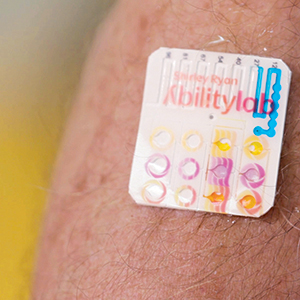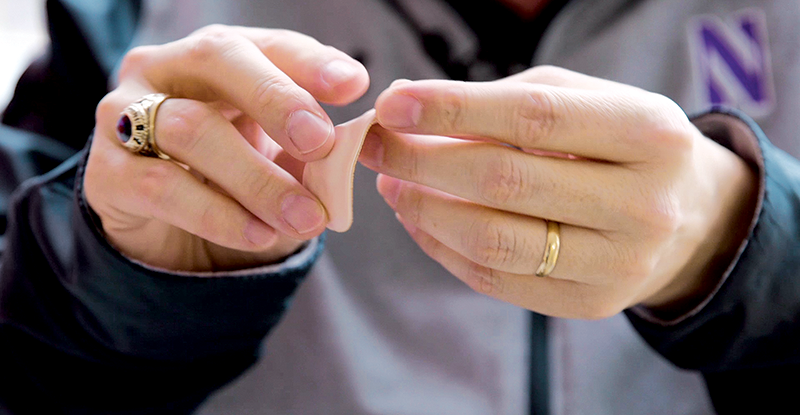Wearables and Wellness
Athletes, military personnel, and stroke patients try out state-of the-art wearables to boost performance, improve readiness, and speed rehabilitation.
Northwestern bioelectronics pioneer John A. Rogers is collaborating with a widely diverse group of partners—including Gatorade, the Seattle Mariners and other professional sports teams, the US Air Force, and Shirley Ryan AbilityLab—to bring his stretchable electronic devices into widespread distribution.
His new microfluidic sweat analytics system measures sweat and sweat biomarkers, allowing users to monitor sweat rate and electrolyte loss. The information helps them keep hydrated, replenish their electrolytes, and stay on top of their game.
 Developed in Rogers’s Northwestern Engineering lab, the soft, flexible device sits on the skin and measures sweat to determine how the body responds to exercise—displaying the results with a simple, real-time visual readout. Launched by Rogers’s group through Northwestern’s Innovation and New Ventures Office (INVO), startup Epicore Biosystems has created large volume manufacturing capabilities for these microfluidic devices. It plans to co-package them with nutritional, skin health, cosmetics, and sports hydration products with future potential use in clinical medicine and rehabilitation.
Developed in Rogers’s Northwestern Engineering lab, the soft, flexible device sits on the skin and measures sweat to determine how the body responds to exercise—displaying the results with a simple, real-time visual readout. Launched by Rogers’s group through Northwestern’s Innovation and New Ventures Office (INVO), startup Epicore Biosystems has created large volume manufacturing capabilities for these microfluidic devices. It plans to co-package them with nutritional, skin health, cosmetics, and sports hydration products with future potential use in clinical medicine and rehabilitation.
"The Gatorade Sports Science Institute knows a great deal about sweat, and they have very rigorous testing protocols for evaluating new technologies in this space,” says Rogers, the Louis Simpson and Kimberly Querrey Professor of Materials Science and Engineering, Biomedical Engineering and Neurological Surgery in McCormick and Northwestern University Feinberg School of Medicine. Rogers is also the director of the Center for Bio-Integrated Electronics.
Lindsay Baker, principal scientist at the Gatorade Sports Science Institute, comments, “Our mission has always been to help athletes optimize their health and performance through research and education in hydration and sports science. Through our partnership with Epicore Biosystems, we’re developing exciting new ways to measure and monitor sweat, which can help us better recommend hydration strategies for our athletes.”
On the Fast Track
Initially introduced in 2016, Rogers’s microfluidic design has come a long way in just a matter of months. Earlier designs measured chloride loss, glucose, lactate, and pH levels in sweat. Newer platforms also quantify concentrations of heavy metals such as lead and arsenic as well as urea and creatinine levels, the latter of which relate to kidney health. The latest devices can also measure these chemistries continuously, allowing wearers to monitor how their sweat chemistry changes during an exercise regimen and throughout the day.
Even better: athletes do not need to pause their workouts to decipher complicated information. Instead, they can monitor these sequentially changing levels with a simple glance. During exercise, sweat flows through the device’s microscopic channels and into different compartments. In those compartments, reactions with chemical reagents result in visible color changes that quantitatively relate to electrolyte concentrations.
“Most people want to know if they are losing a lot of chloride, a little bit, or almost none,” Rogers says. “They can just eyeball the device and determine if their electrolyte levels are high, medium, or low.”
Another unique feature of these latest platforms is the ability to measure users’ sweat during aquatic sports, even when fully under water. New adhesive materials and microfluidic designs maintain watertight seals to the skin. Northwestern’s swim team now uses the system routinely during training and competition.
"We’ve been concerned about the impact of sweating on hydration and performance,” says Jarod Schroeder, head coach of Northwestern’s men’s swimming team, “but until now, we’ve had no way to make quantitative measurements. The remarkably high levels of sweat loss that occur in the pool demand careful scheduling for rehydration.”

Beyond Athletics
Active duty airmen at the Wright-Patterson Air Force Base in Dayton, Ohio, also have begun using the devices. “The ability to monitor sweat loss and sweat chemistry in situ on the skin is of interest because the data may allow us to more effectively manage military readiness under grueling conditions in training or on the battlefield,” says Jennifer Martin, a research chemist for the US Air Force.
Patients also are using the devices at Shirley Ryan AbilityLab, one of the nation’s top translational research hospitals. Researchers there are exploring left/right asymmetries in sweating as a metric for recovery in stroke patients. The devices also help clinicians monitor differences in patients’ sweat chemistry over the course of the rehabilitation process.
"The unique capacity to measure sweating across multiple body locations simultaneously opens up the possibility for using anomalous sweating as an indicator of recovery status.” says Arun Jayaraman, director of the Max Näder Lab for Rehabilitation Technologies and Outcomes Research at Shirley Ryan AbilityLab.
Innovation Continues
Rogers and his team continuously search for new applications for wearable biometric technologies. Stroke patients are using a new bandage-like throat sensor Rogers’s group developed to measure swallowing ability and patterns of speech. The sensors aid in the diagnosis and treatment of aphasia, a communication disorder associated with stroke, and stream data wirelessly to clinicians’ phones and computers.
Because the sensors are wireless, patients can wear them even after they leave the hospital, enabling doctors to monitor how patients are functioning in the real world.
"Talking with friends and family at home is completely different from what we do in therapy,” says Leora Cherney, research scientist at the Shirley Ryan AbilityLab. “Having a detailed understanding of patients’ communication habits outside of the clinic helps us develop better strategies with our patients to improve their speaking skills and speed up their recovery process.”
